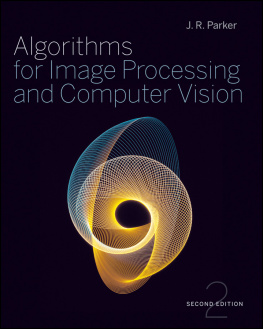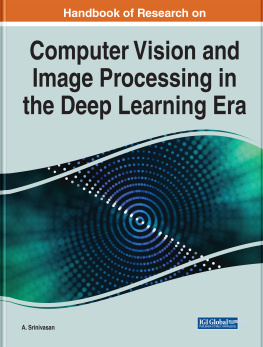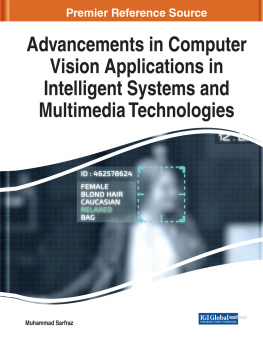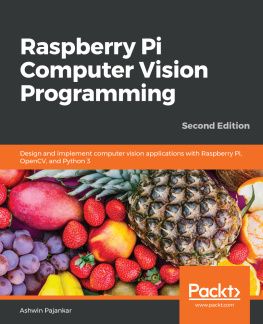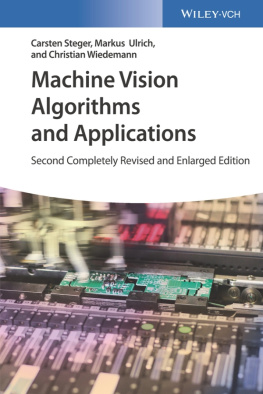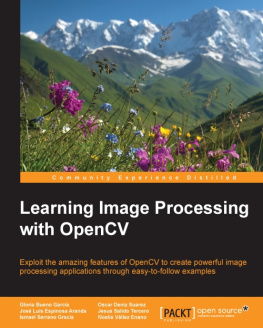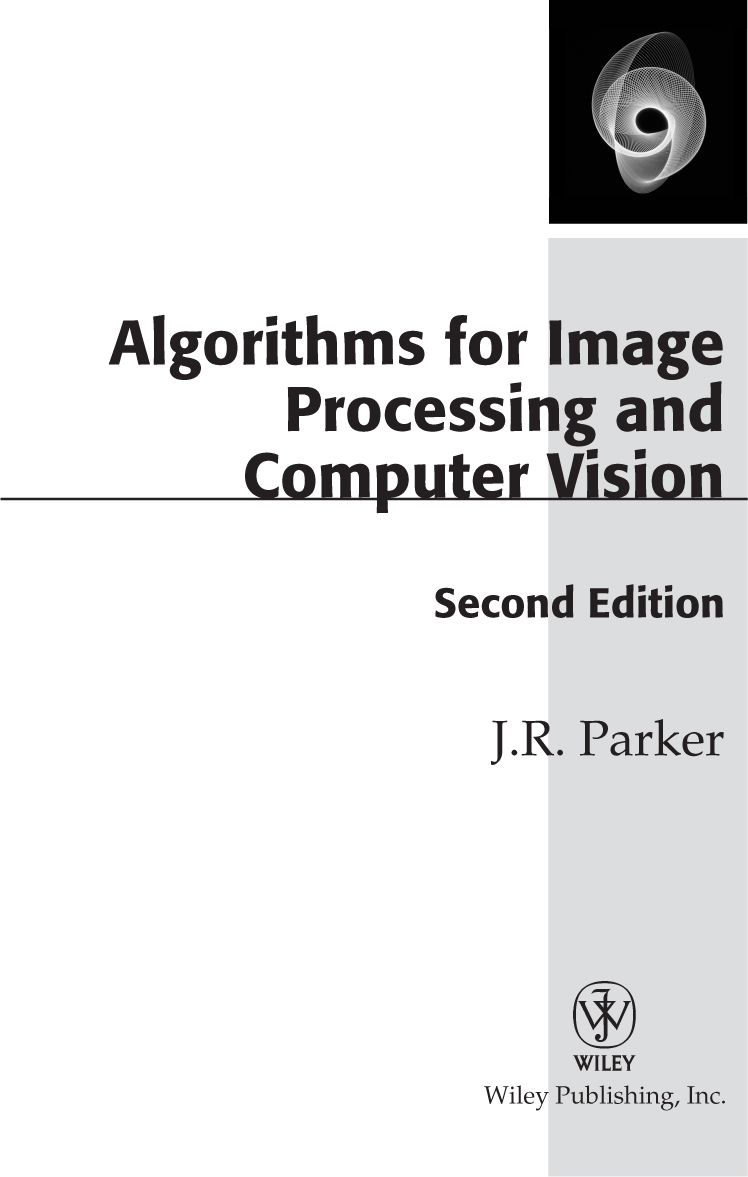Algorithms for Image Processing and Computer Vision, Second Edition
Published by
Wiley Publishing, Inc.
10475 Crosspoint Boulevard
Indianapolis, IN 46256
www.wiley.com
Copyright 2011 by J.R. Parker
Published by Wiley Publishing, Inc., Indianapolis, Indiana
Published simultaneously in Canada
ISBN: 978-0-470-64385-3
ISBN: 978-1-118-02188-0 (ebk)
ISBN: 978-1-118-02189-7 (ebk)
ISBN: 978-1-118-01962-7 (ebk)
No part of this publication may be reproduced, stored in a retrieval system or transmitted in any form or by any means, electronic, mechanical, photocopying, recording, scanning or otherwise, except as permitted under Sections 107 or 108 of the 1976 United States Copyright Act, without either the prior written permission of the Publisher, or authorization through payment of the appropriate per-copy fee to the Copyright Clearance Center, 222 Rosewood Drive, Danvers, MA 01923, (978) 750-8400, fax (978) 646-8600. Requests to the Publisher for permission should be addressed to the Permissions Department, John Wiley & Sons, Inc., 111 River Street, Hoboken, NJ 07030, (201) 748-6011, fax (201) 748-6008, or online at http://www.wiley.com/go/permissions.
Limit of Liability/Disclaimer of Warranty: The publisher and the author make no representations or warranties with respect to the accuracy or completeness of the contents of this work and specifically disclaim all warranties, including without limitation warranties of fitness for a particular purpose. No warranty may be created or extended by sales or promotional materials. The advice and strategies contained herein may not be suitable for every situation. This work is sold with the understanding that the publisher is not engaged in rendering legal, accounting, or other professional services. If professional assistance is required, the services of a competent professional person should be sought. Neither the publisher nor the author shall be liable for damages arising herefrom. The fact that an organization or Web site is referred to in this work as a citation and/or a potential source of further information does not mean that the author or the publisher endorses the information the organization or website may provide or recommendations it may make. Further, readers should be aware that Internet websites listed in this work may have changed or disappeared between when this work was written and when it is read.
For general information on our other products and services please contact our Customer Care Department within the United States at (877) 762-2974, outside the United States at (317) 572-3993 or fax (317) 572-4002.
Wiley also publishes its books in a variety of electronic formats. Some content that appears in print may not be available in electronic books.
Library of Congress Control Number: 2010939957
Trademarks: Wiley and the Wiley logo are trademarks or registered trademarks of John Wiley & Sons, Inc. and/or its affiliates, in the United States and other countries, and may not be used without written permission. All other trademarks are the property of their respective owners. Wiley Publishing, Inc. is not associated with any product or vendor mentioned in this book.
Sin lies only in hurting other people unnecessarily.
All other sins' are invented nonsense.
(Hurting yourself is not a sinjust stupid.)
Robert A. Heinlein
Thanks, Bob.
Credits
Executive Editor
Carol Long
Project Editor
John Sleeva
Technical Editor
Kostas Terzidis
Production Editor
Daniel Scribner
Copy Editor
Christopher Jones
Editorial Director
Robyn B. Siesky
Editorial Manager
Mary Beth Wakefield
Freelancer Editorial Manager
Rosemarie Graham
Marketing Manager
Ashley Zurcher
Production Manager
Tim Tate
Vice President and Executive Group Publisher
Richard Swadley
Vice President and Executive Publisher
Barry Pruett
Associate Publisher
Jim Minatel
Project Coordinator, Cover
Lynsey Stanford
Proofreaders
Nancy Hanger, Paul Sagan
Indexer
Ron Strauss
Cover Image
Ryan Sneed
Cover Designer
GYRO PHOTOGRAPHY/amanaimagesRB/Getty Images
About the Author
J.R. Parker is a computer expert and teacher, with special interests in image processing and vision, video game technologies, and computer simulations. With a Ph.D. in Informatics from the State University of Gent, Dr. Parker has taught computer science, art, and drama at the University of Calgary in Canada, where he is a full professor. He has more than 150 technical papers and four books to his credit, as well as video games such as the Booze Cruise , a simulation of impaired driving designed to demonstrate its folly, and a number of educational games. Jim lives on a small ranch near Cochrane, Alberta, Canada with family and a host of legged and winged creatures.
About the Technical Editor
Kostas Terzidis is an Associate Professor at the Harvard Graduate School of Design. He holds a Ph.D. in Architecture from the University of Michigan (1994), a Masters of Architecture from Ohio State University (1989), and a Diploma of Engineering from the Aristotle University of Thessaloniki (1986). His most recent work is in the development of theories and techniques for the use of algorithms in architecture. His book Expressive Form: A Conceptual Approach to Computational Design , published by London-based Spon Press (2003), offers a unique perspective on the use of computation as it relates to aesthetics, specifically in architecture and design. His book Algorithmic Architecture (Architectural Press/Elsevier, 2006) provides an ontological investigation into the terms, concepts, and processes of algorithmic architecture and provides a theoretical framework for design implementations. His latest book, Algorithms for Visual Design (Wiley, 2009), provides students, programmers, and researchers the technical, theoretical, and design means to develop computer code that will allow them to experiment with design problems.
Acknowledgments
Thanks this time to Sonny Chan, for the inspiration for the parallel computing chapter, to Jeff Boyd, for introducing me repeatedly to OpenCV, and to Ralph Huntsinger and Ghislain C. Vansteenkiste, for getting me into and successfully out of my Ph.D. program.
Almost all the images used in this book were created by me, using an IBM PC with a frame grabber and a Sony CCD camera, an HP scanner, and a Sony Eyetoy as a webcam. Credits for the few images that were not acquired in this way are as follows:
Corel Corporation made available the color image of the grasshopper on a leaf shown in Figure 3.33, and also was the origin of the example search images in Figure 10.5.
The sample images in Figure 10.1 were a part of the ALOI data set, use of which was allowed by J. M. Geusebroek.
Thanks to Big Hill Veterinary Clinic in Cochrane, Alberta, Canada, for the X-ray image shown in Figure 3.10e.
Finally, thanks to Dr. N. Wardlaw, of the University of Calgary Department of Geology, for the geological micropore image of Figure 3.16.
Most importantly, I need to thank my family: my wife, Katrin, and children, Bailey and Max. They sacrificed time and energy so that this work could be completed. I appreciate it and hope that the effort has been worthwhile.
Preface
Humans still obtain the vast majority of their sensory input through their vi-sual system, and an enormous effort has been made to artificially enhance this sense. Eyeglasses, binoculars, telescopes, radar, infrared sensors, and photo-multipliers all function to improve our view of the world and the universe. We even have telescopes in orbit (eyes outside the atmosphere) and many of those see in other spectra: infrared, ultraviolet, X-rays. These give us views that we could not have imagined only a few years ago, and in colors that we'll never see with the naked eye. The computer has been essential for creating the incredible images we've all seen from these devices.

